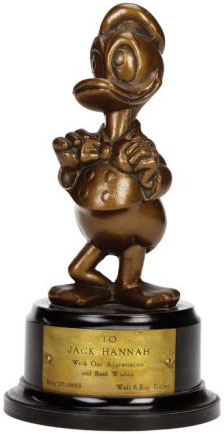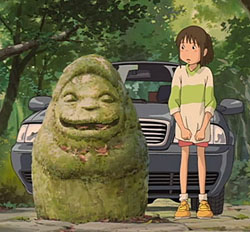 Jack and the Beanstalk. Jack Hannah was the first Disney animator I ever met and interviewed. I interviewed him several times beginning in 1977 and each time, there was always something new and surprising that he hadn’t previously mentioned. Here is one such anecdote from him: “One interesting thing about doing storyboards is I remember being called in by Wilfred Jackson. I can’t recall whether he had asked for me specifically or just asked for whoever was available but I remember sitting alone in the story room and storyboarding in water color the growing sequence of the beanstalk that was used in Mickey and the Beanstalk (1947). Again, you did whatever needed to be done. I was happy to do it but I don’t think people know that I did it.”
Jack and the Beanstalk. Jack Hannah was the first Disney animator I ever met and interviewed. I interviewed him several times beginning in 1977 and each time, there was always something new and surprising that he hadn’t previously mentioned. Here is one such anecdote from him: “One interesting thing about doing storyboards is I remember being called in by Wilfred Jackson. I can’t recall whether he had asked for me specifically or just asked for whoever was available but I remember sitting alone in the story room and storyboarding in water color the growing sequence of the beanstalk that was used in Mickey and the Beanstalk (1947). Again, you did whatever needed to be done. I was happy to do it but I don’t think people know that I did it.”
Two Ducksters. It is frustrating that the Disney Company did not adequately document certain things like how many Mousecars and Duckster statuettes were handed out over the years. However, it is known that the first Ducksters were given out in 1952 by Walt Disney. While researching something about Jack Hannah, I looked at the profile for Clarence Nash in The New Yorker magazine December 29,1975 and found this tidbit: “The mantel (in Clarence Nash’s Glendale home) has two identical Donald Duck bronze statuettes on wooden bases. One is from Roy Disney, Walt’s brother and business partner and is inscribed ‘To Clarence Nash, in appreciation of your continuous years of service 1933-1969’. The base of the second statuette bears the printed legend ‘Best personal wishes, Walt Disney 1952’.”
 What Makes a Cartoon A Cartoon? From The Onion March 4, 2001 Volume 37, Issue 12, animator and director John Kricfalusi on what makes a cartoon a cartoon: “What makes a cartoon a cartoon is that it can do things that you can’t do in any other medium. Just like any medium. What makes music ‘music’ is melody and rhythm and a million variations on those things – a pleasant melody, normally unless you’re talking about modern music. If you took those out, it wouldn’t be music anymore.
What Makes a Cartoon A Cartoon? From The Onion March 4, 2001 Volume 37, Issue 12, animator and director John Kricfalusi on what makes a cartoon a cartoon: “What makes a cartoon a cartoon is that it can do things that you can’t do in any other medium. Just like any medium. What makes music ‘music’ is melody and rhythm and a million variations on those things – a pleasant melody, normally unless you’re talking about modern music. If you took those out, it wouldn’t be music anymore.
“So in cartoons, what makes it cartoony is that you’re doing things that are impossible to do. You have characters that have strong, personalities, but they can do crazy things. If you watch a Bugs Bunny cartoon, they squash and stretch and make funny expressions, and they do all kinds of things that you laugh at visually.
“You couldn’t do anything like that in the 70s and 80s. It was against the law. They thought you were crazy if you did anything like that. They said, ‘The way you’re drawing the character looks weird!’ Well, it’s supposed to look weird. It’s a cartoon. I swear, all the people in charge of cartoons that had never seen a cartoon before except for the 70s ones.”
Burping Rick. In an interview with Entertainment Weekly July 31, 2015, Justin Roiland, co-creator of Adult Swim’s Rick and Morty and voice of both of those characters, explained why the character of Rick burps so much: “In 2006 or something, I was recording the voices for this short ‘The Real Adventures of Doc and Mharti’. I was having fun doing these really crappy Doc Brown and Marty McFly impressions. During the middle of a line, a burp came out naturally.
“It was just so funny and gross. I was like ‘Well, let’s see if I can do that again for a couple more lines’. Then with ‘Rick and Morty’, Dan (Harmon, the show’s co-creator) was like ‘Hey, Adult Swim wants to do a show. Do you have any ideas?’ I said, ‘Well what about these two voices?’ Right out of the gate the burping was part of it.
“I’m not a big burper. It’s not easy for me to do. Ironically, Sarah (Chalke who voices Rick’s daughter Beth) can burp on command. She’s incredible. I’m so jealous of her. I have to sit there with a low-calorie beer and a bottle of water and wait for it to work its way up. I tell the engineer that records the show ‘Just leave it rolling because I don’t know when this burp is coming!’ It’s a disgusting process.”
Woody’s Singer. Animation history is filled with entertaining but incorrect stories. Walter Lantz loved to tell the story that for Woody Woodpecker’s short Barber of Seville (1944) that a distinguished opera star was hired for the singing and became horrified that it was for an animated character. As voice expert Keith Scott pointed out in Devon Baxter’s post earlier this week, Woody Woodpecker’s singing was done by baritone Lee Sweetland known for his singing work on NBC radio. He sang for Woody in Ski For Two (1944) as well as Barber of Seville. His wife was Sally Mueller (sometimes billed as Sally Sweetland) who was also a professional session soloist and is one of the singers on the Bambi soundtrack. Lee can be heard as the operatic hog-caller in the Disney Silly Symphony Farmyard Symphony (1938).
The Emptiness of Miyazaki. Hayao Miyazaki told film critic Roger Ebert in an article for the September 19,2002 Chicago Sun-Times: “I am 62. I wanted to retire but life isn’t that easy. I wanted to make a movie especially for the daughters of my friends. I opened all the drawers in my head. They were all empty. So I realized I had to make a movie just for ten year olds and Spirited Away (2001) is my answer.

Spirited Away
“The people who make the movies are scared of silence so they want to paper and plaster it over. They’re worried the audience will get bored. They might go up and get some popcorn. But just because it’s 80 percent intense all the time doesn’t mean the kids are going to bless you with their concentration. What really matters is the underlying emotions – that you never let go of those.
“What my friends and I have been trying to do since the 1970s is to try and quiet things down a little bit. Don’t just bombard them with noise and distraction. And to follow the path of children’s emotions and feelings as we make a film. If you stay true to joy and astonishment and empathy. You don’t have to have violence. You don’t have to have action. They’ll follow you. This is our principle.”


 Jim Korkis is an internationally respected animation historian who in recent years has devoted his attention to the many worlds of Disney. He was a columnist for a variety of animation magazines. With his former writing partner, John Cawley, he authored several animation related books including The Encyclopedia of Cartoon Superstars, How to Create Animation, Cartoon Confidential and Get Animated’s Animation Art Buyer’s Guide. He taught animation classes at the Disney Institute in Florida as well as instructing classes on acting and animation history for Disney Feature Animation: Florida.
Jim Korkis is an internationally respected animation historian who in recent years has devoted his attention to the many worlds of Disney. He was a columnist for a variety of animation magazines. With his former writing partner, John Cawley, he authored several animation related books including The Encyclopedia of Cartoon Superstars, How to Create Animation, Cartoon Confidential and Get Animated’s Animation Art Buyer’s Guide. He taught animation classes at the Disney Institute in Florida as well as instructing classes on acting and animation history for Disney Feature Animation: Florida.




















































I have to admit, I agree with John K. 100%, and this theory doesn’t only apply to stretch and squash. A character can be seen as abstract just to add to the atmosphere in a cartoon or to emphasize an emotion. There are things that can be done as animation that would simply be boring, even as special effects in live action. I still come back to that unique stop motion type of animation in which you can even use live actors for each frame of your surreal cartoon, something like Norman McClarren (sp). I wonder what John Kricfalusi would have done with that kind of visual!! Where I disagree, and I suppose I shouldn’t even have an opinion, but, is when an animator says that animating humans is boring, that it is much more interesting to bring human emotions to either inanimate objects or to animals. True, this is a great aspect of why a cartoon *IS* a cartoon and why it works, but humans are a tapestry all their own, and not just as exaggerated caricature. Just look again at silent slapstick or just think of comic situations in live action films and think of how you would put that situation into an animated film and where you’d drive the situation to exaggerate and drive home the point. Were not all the “red” girls in Tex Avery cartoons human? Were they not all relatively sexy? And all that was done without angering those who strove to keep the “integrity” of that stupid Hays Code…I also liked the thoughts of Hayao Miazaki about the pacing of a good full length animated motion picture. Yet, although a cartoon has always managed to hold my attention, I wonder how you can change popular belief that a cartoon cannot keep an audience amused for two hours. I’d love to see animated motion pictures go beyond wht is widely accepted today. So much animation is hesitant to do certain things because it is still seen as kids’ entertainment, not that there is anything wrong with that, but it is a shame to trap an animator’s talent in that stronghold. It’s like saying that only one form of music *IS* music while the rest is noise. That just isn’t true.
I was always under the impression that Rick was trying to hold back from throwing up due to his massive habit of drinking. I didn’t know that was supposed to be burping.